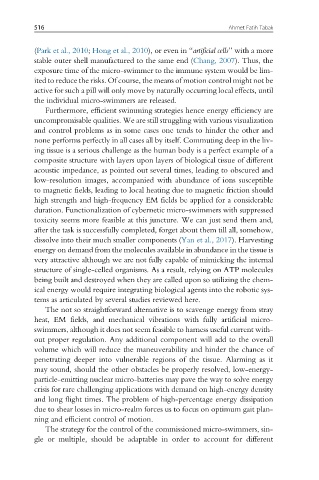Page 523 - Handbook of Biomechatronics
P. 523
516 Ahmet Fatih Tabak
(Park et al., 2010; Hong et al., 2010), or even in “artificial cells” with a more
stable outer shell manufactured to the same end (Chang, 2007). Thus, the
exposure time of the micro-swimmer to the immune system would be lim-
ited to reduce the risks. Of course, the means of motion control might not be
active for such a pill will only move by naturally occurring local effects, until
the individual micro-swimmers are released.
Furthermore, efficient swimming strategies hence energy efficiency are
uncompromisable qualities. We are still struggling with various visualization
and control problems as in some cases one tends to hinder the other and
none performs perfectly in all cases all by itself. Commuting deep in the liv-
ing tissue is a serious challenge as the human body is a perfect example of a
composite structure with layers upon layers of biological tissue of different
acoustic impedance, as pointed out several times, leading to obscured and
low-resolution images, accompanied with abundance of ions susceptible
to magnetic fields, leading to local heating due to magnetic friction should
high strength and high-frequency EM fields be applied for a considerable
duration. Functionalization of cybernetic micro-swimmers with suppressed
toxicity seems more feasible at this juncture. We can just send them and,
after the task is successfully completed, forget about them till all, somehow,
dissolve into their much smaller components (Yan et al., 2017). Harvesting
energy on demand from the molecules available in abundance in the tissue is
very attractive although we are not fully capable of mimicking the internal
structure of single-celled organisms. As a result, relying on ATP molecules
being built and destroyed when they are called upon so utilizing the chem-
ical energy would require integrating biological agents into the robotic sys-
tems as articulated by several studies reviewed here.
The not so straightforward alternative is to scavenge energy from stray
heat, EM fields, and mechanical vibrations with fully artificial micro-
swimmers, although it does not seem feasible to harness useful current with-
out proper regulation. Any additional component will add to the overall
volume which will reduce the maneuverability and hinder the chance of
penetrating deeper into vulnerable regions of the tissue. Alarming as it
may sound, should the other obstacles be properly resolved, low-energy-
particle-emitting nuclear micro-batteries may pave the way to solve energy
crisis for rare challenging applications with demand on high-energy density
and long flight times. The problem of high-percentage energy dissipation
due to shear losses in micro-realm forces us to focus on optimum gait plan-
ning and efficient control of motion.
The strategy for the control of the commissioned micro-swimmers, sin-
gle or multiple, should be adaptable in order to account for different

